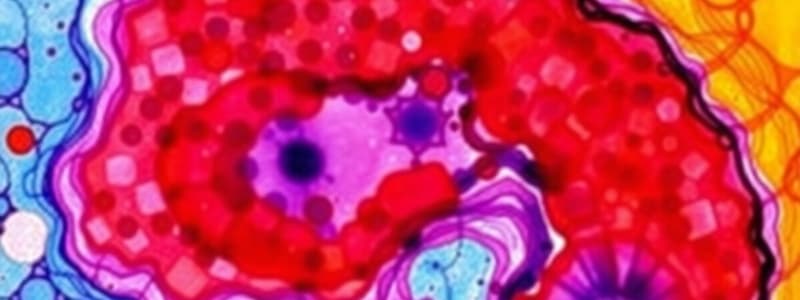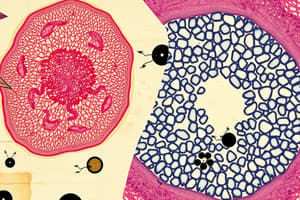Podcast
Questions and Answers
What is the primary function of connective tissues?
What is the primary function of connective tissues?
- To facilitate gas exchange
- To protect, support, or bind other tissues (correct)
- To conduct electrical impulses
- To absorb nutrients
Which component of the extracellular matrix provides strength and support to connective tissues?
Which component of the extracellular matrix provides strength and support to connective tissues?
- Collagen fibers (correct)
- Reticular fibers
- Elastic fibers
- Ground substance
What type of connective tissue is characterized by a non-living extracellular matrix?
What type of connective tissue is characterized by a non-living extracellular matrix?
- Epithelium
- Nervous tissue
- Muscle tissue
- Connective tissue (correct)
Which type of fiber in connective tissues can be stretched up to 150 times its relaxed length?
Which type of fiber in connective tissues can be stretched up to 150 times its relaxed length?
What is the basic composition of connective tissue's extracellular matrix?
What is the basic composition of connective tissue's extracellular matrix?
Which type of fibers in connective tissues provide a branching network for support?
Which type of fibers in connective tissues provide a branching network for support?
Which of the following connective tissues is primarily found in tendons and ligaments?
Which of the following connective tissues is primarily found in tendons and ligaments?
What is the role of the ground substance in connective tissue?
What is the role of the ground substance in connective tissue?
What shapes are the acini in the pancreas primarily described as?
What shapes are the acini in the pancreas primarily described as?
What characteristic feature differentiates acini in salivary glands?
What characteristic feature differentiates acini in salivary glands?
What is the typical shape of acinar cells in sebaceous glands?
What is the typical shape of acinar cells in sebaceous glands?
Where are sudoriferous glands generally located?
Where are sudoriferous glands generally located?
What color typically represents connective tissue and blood vessels in pancreatic tissue descriptions?
What color typically represents connective tissue and blood vessels in pancreatic tissue descriptions?
What visual characteristic is noted for pancreatic ducts?
What visual characteristic is noted for pancreatic ducts?
What term describes the spherical clusters of cells in the pancreas?
What term describes the spherical clusters of cells in the pancreas?
What does the term 'lumen' refer to in the context of glands?
What does the term 'lumen' refer to in the context of glands?
What characterizes simple squamous epithelium?
What characterizes simple squamous epithelium?
Which type of epithelium features cells that are taller than they are wide?
Which type of epithelium features cells that are taller than they are wide?
What feature distinguishes pseudostratified ciliated columnar epithelium?
What feature distinguishes pseudostratified ciliated columnar epithelium?
Which of the following epithelium types typically contains microvilli?
Which of the following epithelium types typically contains microvilli?
What is a distinguishing feature of skeletal muscle tissue?
What is a distinguishing feature of skeletal muscle tissue?
Which type of muscle tissue is considered involuntary?
Which type of muscle tissue is considered involuntary?
What is the primary function of simple cuboidal epithelium?
What is the primary function of simple cuboidal epithelium?
Where are the nuclei located in skeletal muscle fibers?
Where are the nuclei located in skeletal muscle fibers?
In which locations would you typically find simple columnar epithelium?
In which locations would you typically find simple columnar epithelium?
What unique structure is found in cardiac muscle tissue?
What unique structure is found in cardiac muscle tissue?
Which type of epithelium has nuclei located at different levels along the cells?
Which type of epithelium has nuclei located at different levels along the cells?
Which term best describes the contraction type of skeletal muscles?
Which term best describes the contraction type of skeletal muscles?
What is not a characteristic of simple cuboidal epithelium?
What is not a characteristic of simple cuboidal epithelium?
How do leukocytes differ from erythrocytes in terms of structure?
How do leukocytes differ from erythrocytes in terms of structure?
What is the primary function of muscle tissue?
What is the primary function of muscle tissue?
Which feature distinguishes cardiac muscle from skeletal muscle?
Which feature distinguishes cardiac muscle from skeletal muscle?
What is a function of intercalated discs in cardiac muscle tissue?
What is a function of intercalated discs in cardiac muscle tissue?
How do smooth muscle cells and skeletal muscle fibers differ in their control?
How do smooth muscle cells and skeletal muscle fibers differ in their control?
What describes the shape of smooth muscle cells?
What describes the shape of smooth muscle cells?
Which of the following accurately describes neurons?
Which of the following accurately describes neurons?
What distinguishes cardiac muscle cells from skeletal muscle fibers?
What distinguishes cardiac muscle cells from skeletal muscle fibers?
What structural feature primarily helps identify axons from dendrites?
What structural feature primarily helps identify axons from dendrites?
Which of the following statements is true about smooth muscle?
Which of the following statements is true about smooth muscle?
What describes the function of neuroglia?
What describes the function of neuroglia?
Flashcards are hidden until you start studying
Study Notes
Simple Squamous Epithelium
- Single layer of flattened cells
- Found in air sacs of lungs, lining of blood vessels, lymphatic vessels and body cavities
Simple Cuboidal Epithelium
- Single layer of cube-shaped cells
- Large, central nucleus
- Located in glands, kidney tubules, covering the ovary
- Functions in secretion and absorption
Simple Columnar Epithelium
- Single layer of tall, narrow cells
- Oval shaped nucleus in the lower half of the cell
- May contain goblet cells (secreting mucus) and microvilli (increase surface area for absorption)
- Found in lining of stomach, intestines, gallbladder, uterus
Pseudostratified Ciliated Columnar Epithelium
- Single layer of cells, but appears stratified
- Not all cells reach the lumen, nuclei seen at different levels
- Contains goblet cells and cilia
- Found in trachea, bronchi, lining of the nasal cavity
- Functions in moving mucus and debris
Pancreas
- Clusters of dark purple cells (acini) secrete digestive enzymes
- Lighter purple cells (islets) secrete hormones
- Found in the abdomen
Salivary Gland
- Visible ducts and acini
- Different appearance of acini depending on type of gland: serous fluid or mucus secretion
- Found in the mouth
Sebaceous Gland
- Acinar cells are tear-drop shaped
- Lumen very narrow
- Located beside the hair follicle
- Secretes sebum (oil)
Sudoriferous Gland
- Coiled, tubular glands
- Lumen visible in coiled regions
- Located in the deep dermis or upper subcutaneous region
- Secretes sweat
Connective Tissues
- Function: protection, support, binding, insulation, transport, energy storage
- Characteristics:
- Non-living extracellular matrix
- Scattered cells
- Highly vascularized
- Extracellular matrix consists of:
- Ground substance (fluid, semi-fluid, gelatinous, hard)
- Fibers: collagen, elastic, reticular
Blood
- Liquid connective tissue
- Contains red blood cells (erythrocytes), white blood cells (leukocytes), platelets
- Functions in transport of oxygen, nutrients, waste, and hormones
Skeletal muscle
- Long, cylindrical, striated fibers
- Multiple nuclei on the periphery
- Voluntary control
- Found attached to bones
Cardiac muscle
- Short, branched cells
- Single, central nucleus
- Intercalated discs and striations
- Involuntary control
- Found in heart
Smooth muscle
- Short, spindle-shaped cells
- Single, central nucleus
- Involuntary control
- Found in walls of internal organs
Nervous Tissue
- Composed of neurons and neuroglia
- Neurons convert stimuli into electrical signals
- Neuroglia support neurons
- Neurons have three parts: cell body, dendrites, axons
Neurons
- Large cell body with multiple extensions
- Found in brain, spinal cord, nerves
- Function in communication and coordination
Neuroglia
- Smaller and more numerous than neurons
- Support and protect neurons
Studying That Suits You
Use AI to generate personalized quizzes and flashcards to suit your learning preferences.




